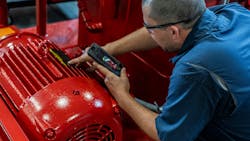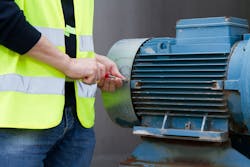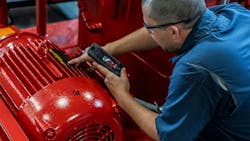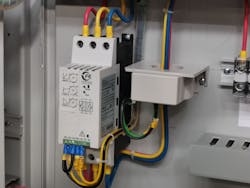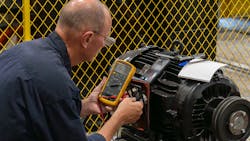VFDs & Motors: Remotely Troubleshoot Successfully and Safely
One of the dilemmas in today’s industrial world is finding enough technically capable employees to keep equipment up and running to meet the growing demands of production lines. Many companies don’t have the human power or resources for 24/7 on-site maintenance for equipment, especially when it fails due to technical issues.
While modern hardware and electronics offer many avenues for companies to provide access for maintenance and electrical personnel, most will find that this adds complications and expenses that exceed their scope. When placed on a network, HMIs (human machine interfaces), PLCs (programmable logic controllers), VFDs (variable frequency drives), sensors, vision systems and other devices allow approved personnel unlimited access to data from almost anywhere in the world.
This connectivity can enable remote troubleshooting of machine components such as VFDs and motors, helping to overcome the challenges of limited technical resources when a maintenance issue arises. However, there are several aspects which need to be taken into account to ensure safe and successful remote troubleshooting.
The Challenge: Who Will Maintain the Equipment?
As production demands increase, the shortage of workers, especially those with higher technical capabilities, has forced companies to assess their after-hours responses to breakdowns and failures. For example, they may only have one person who knows how to evaluate PLC code or understands the layers of VFD parameters. When this person goes home for the day, what happens when a problem arises beyond the knowledge level of the maintenance person now on the clock?
In a perfect world, a qualified technician would cover all shifts, but that is not always possible.
Distance can also be a factor, where certain employees may live close enough to be called in for technical support, while others may live impractically far away. Or, with certain OEMs and companies with multiple locations, the most qualified person to analyze the problem may live hundreds of miles away.
Proper Maintenance Preparation
The first step companies should consider for failure events is proper preparation. This comes down to identifying which production lines or equipment must keep running and what steps should be followed when things go wrong.
Assuming that a plant may not have enough technicians or mechanics to adequately provide round-the-clock coverage, a well-thought-out game plan will shorten the time needed to recover.
An evaluation should include:
- Identifying the knowledge level or technical expertise needed for each production line.
- Assessing personnel and their qualifications and responsibilities.
- Assessing safety, which includes safety personnel, mechanics and electricians familiar with the known dangers.
- Sharing the location of equipment records, including the lockout/tagout (LOTO) instructions.
- Deciding if an outside person or contractor is needed for any line.
Each production line’s complexity needs to be closely evaluated to determine what requires higher levels of technical support. Are there dedicated employees for each item, or are they considered multi-craft, trained in various electronics and motors?
After the initial assessment of personnel and their required after-hours responsibilities, the highest priority must be given to safety:
- Are the on-site personnel qualified to work on live electrical circuits or VFDs that have to be powered up to scan through the parameters or fault log? Can they use meters for testing and troubleshooting?
- Do on-site personnel know the difference between a meter's AC and DC voltage settings?
- Does the plant have a written LOTO policy with proper items available to the maintenance or electricians throughout the workplace and after hours?
All of this should be decided before a failure so there are no surprises and the dangers are minimized as much as possible.
Often, a local contractor is called in to perform these tasks. Never assume that the outside contractor or technician is qualified for the test equipment. For example, a contractor assigned to the task may be highly trained and experienced in mechanical fields but lack the confidence to successfully test electrical circuits. Listen to the warning signs over the phone, such as, “What setting do I use for the digital meter dial?” or “Where do I put the leads?” or “Can I do this with the power on?” Never push or ask any technician to perform a job or evaluation that they are uncomfortable performing.
Once you decide to call in an outside person, their name and contact information should be available to the plant personnel. The plant personnel responsible for calling should be established in advance to follow the necessary chain of command. This prevents unnecessary calls that could wait until the next day, which may prevent excessive overtime charges.
If needed, staff engineers, technicians or mechanics should have wiring diagrams, assembly drawings, copies of parameters or programs, and other pertinent information. They may be allowed to keep hard copies at home or digital files on their laptops for assisting on-site team members or contractors over the phone.
Most importantly, follow guidelines to ensure that proper personal protective equipment (PPE) is readily available and worn by the on-site worker.
READ MORE: A Variable-Speed Revolution in Hydraulics
Potential Communication Issues
Modern devices such as Wi-Fi adaptable headsets with visual and audio capabilities — such as a cellphone app for video calls — allow a remote person to see and hear what is happening on site. However, these are not always available or convenient. Take, for example, a motor problem in a compressor room: How do you communicate with someone who needs to wear earplugs in a noisy environment that makes hearing instructions difficult?
The technician must often be given step-by-step instructions, and the results are relayed back to the person helping on the phone (Figure 1). This could be accomplished with an assistant or simply waiting for a reply by phone or text.
A brief introduction should be required between the person calling in remotely and the person doing the on-site troubleshooting. Each should know the other’s name and at least their phone number in case they get disconnected or need to talk further at another time.
Start by asking the technician if they are OK performing electrical and mechanical testing, or programming and evaluating parameters. Do they have the tools necessary for the required tasks? Patience will be your highest priority since the on-site person may concentrate on a test procedure, while the remote person may have already presumed the result before receiving the reply. The person on site may not be on the same page as the person acting remotely, so the problem of going down different paths may be the short-term result of improper communication.
How to Get Started with Remote Troubleshooting
Remotely troubleshooting equipment such as VFDs and motors requires experience, but more than that, it requires patience. Jumping to conclusions and ignoring basic safety will only lead to more issues and jeopardize on-site personnel. Never assume that the person on the other end has the knowledge and training to understand and follow basic steps you may take for granted.
This person performing the actual hands-on testing may be a mechanic — not an electrician — so be cautious about how far and in-depth they are pushed to get the equipment back up and running. It is far better to know when to stop the testing process and wait for more qualified personnel to arrive than to place a person or a machine in greater danger.
When beginning the troubleshooting process, the on-site person must ensure that proper PPE is worn. As for the remote person, they must start with the basics. The first question to the on-site troubleshooter should center around what happened before the failure, fault or shutdown. Knowing what was going on right before something went wrong is important.
The remote person must assume that the correct information will not be forthcoming, perhaps even from production workers reluctant to explain a situation that would blame someone for a mistake. More than likely, the person assigned to finding the issue will not know or understand exactly what happened, which is why they are calling someone else in the first place.
Look for simple cause-and-effect situations first, like thunderstorms, power fluctuations, excessive load demands, unusual changes in products, and other outside forces that may have played a factor.
Next, it is important to note that many techs or mechanics initially blame the most complicated hardware, like the VFD or PLC. If this piece of equipment has successfully run for a long time, it would indicate that the programming and other related parameters are correct.
For example, a simple blown fuse on the three-phase input of a VFD would still allow it to run. But that would limit its current output, causing an over-current trip that a mechanic may assume was due to a programming error. Many technicians would suspect the motor was bad or overloaded, not knowing that the VFD could run with only two input fuses. Most VFDs will have a fault log history that can reveal a pattern leading to the current failure, even if someone has already pressed the reset button.
It is easy to get pointed in the wrong direction and focus too much on related or unrelated events when the problem lies elsewhere. This makes it especially difficult for a person helping by phone with the testing process, unless they are prepared to ask the correct questions, comprehend the replies, and understand how the multiple paths are related to the core failure event.
As the remote person, you may need to start by checking a motor, depending on its horsepower and voltage ratings. Ask the on-site tech to perform simple checks with a meter, looking for problems or direct shorts (Figure 2). Always remember that a megohm meter will put a high voltage into the motor windings to find shorts, but be careful with what range is used to prevent further damage.
As a side note, never use a megger on a motor still connected to a VFD, because the resulting voltage could damage the output transistors. Ask the technician if they can isolate the motor’s leads through a contactor or disconnect device. Measure from leg to leg and each leg to ground to find anomalies or inconsistent readings. In a high-noise area, the on-site tech can write down these readings and move to another area of the plant. Less noise will allow them to communicate with the remote person assisting and analyzing the findings.
Using a sensor, transducer, or other I/O (input/output) often causes problems on another device. A VFD, for example, may use a transducer input inside a feedback loop to determine its final speed. If this transducer fails, the reading may reach zero or maximum value, leading the VFD to run at a minimum or maximum frequency without showing a trip condition.
It may be easier to blame the parameters inside the VFD without realizing it is running correctly based on the faulty input. The remote person must consider these factors and find a baseline to build on. Determine what seems to be working, even during a failure.
READ MORE: GFCI-Protected Circuits: Don’t Get Tripped up by VFDs
The Benefits of Condition Monitoring
Adding various condition-monitoring devices greatly lessens the time required to track down the causes of failure, significantly reducing the need for a remote call. Compared to the costs of production downtime and labor charges, even adding simple sensors could be inexpensive.
Transducers, meters and other I/O could be added to provide production workers, maintenance personnel and engineers the data required to monitor the equipment while running. This would obtain a baseline and potentially sound the alarm when events start to deviate. There might be enough forewarning to schedule the machine for the anticipated correction event.
The best solution to remote troubleshooting is to have an established protocol and practice, practice, practice while on site. The safety of an on-site person on the other end of a phone is difficult to ensure, even when you know each other. The remote person called on must imagine what they would do if they were the one performing the work. Sometimes, that may require asking other plant personnel to assist, especially if they are familiar with the equipment and the dangers that may not be evident to an outsider.
The production worker will often know more about the operation and risks but offer their opinion only if asked. Even with a contractor who has been called into a plant, explain what the machine is expected to do and what troubleshooting steps you will take, and express your knowledge about what to look for.
Even though troubleshooting remotely has challenges, a well-thought-out plan will allow everyone to succeed, especially when everyone goes home safely.
This article was written and contributed by Matt Asbill who has been an automation specialist at Motion for 30 years. He worked on government, aerospace and military projects for 6 years prior. Asbill holds a BS in Electronic Technology from Missouri State University and an MS in Engineering Technology from Pittsburg State University.
About the Author
Matt Asbill
Automation Specialist, Motion
Matt Asbill has been an automation specialist at Motion for 30 years. He worked on government, aerospace and military projects for six years prior. Asbill holds a BS in Electronic Technology from Missouri State University and an MS in Engineering Technology from Pittsburg State University.

Leaders relevant to this article:
